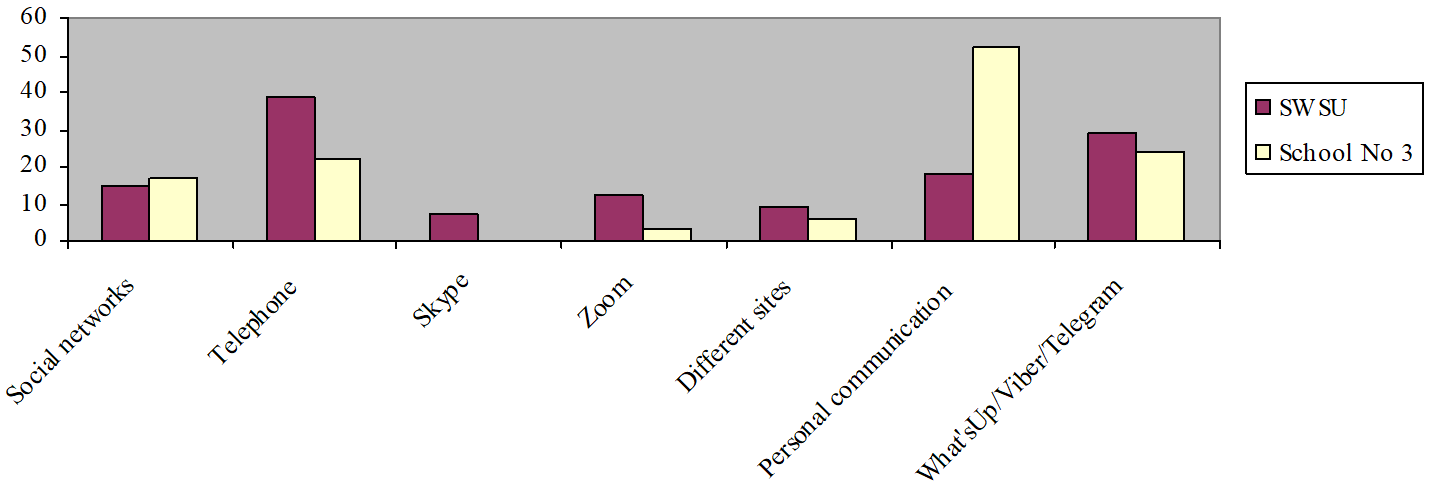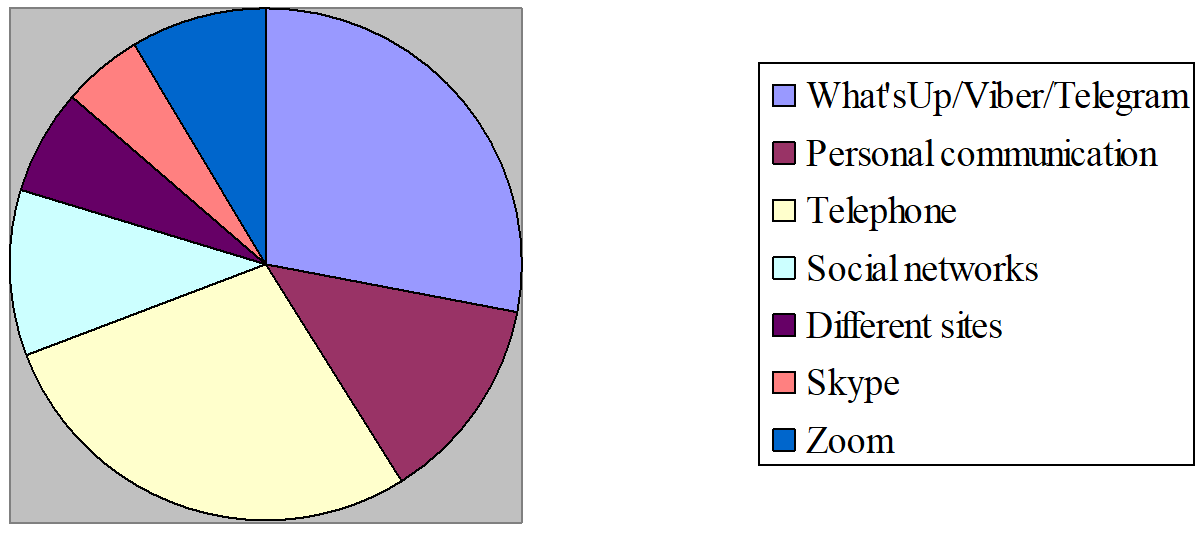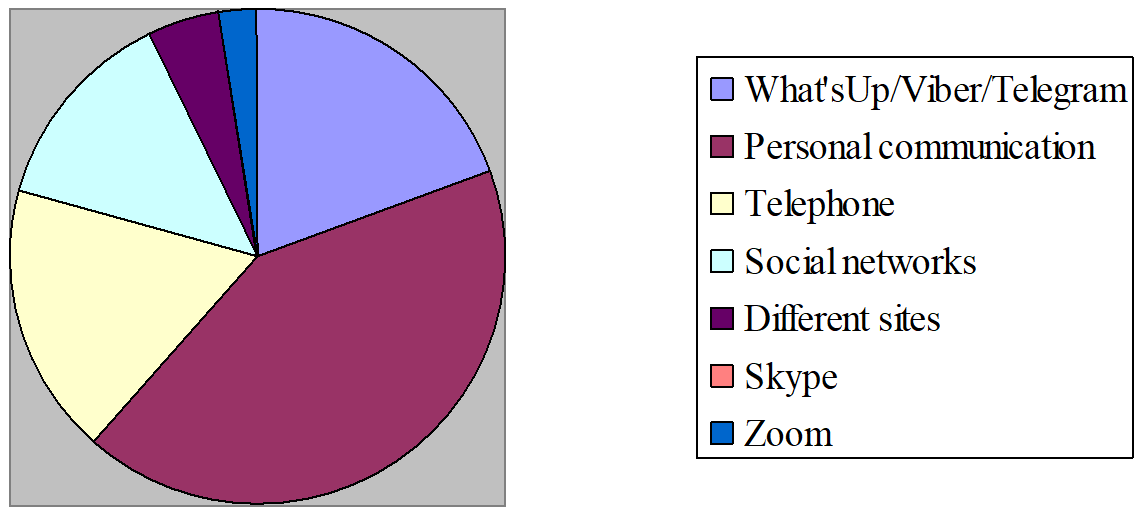Teenagers’ communication of different age and social groups in the Internet
Teenagers’ communication of different age and social groups in the Internet
Abstract
This article discusses different forms of communication between two age and social groups. Nowadays, young people prefer spending their free time alone with computer and the Internet. To study the role of communication in the life of modern youth, the author conducted an experimental study among students of South-West State University and schoolchildren of the secondary school No. 3 in Kursk. The most popular forms of communication were identified: personal communication, telephone, social networks, What'sApp, Viber, Telegram and others. Among the reasons for the appeal of adolescents to one or another form of communication were identified: communication, study, work, curiosity, search and storage of information, and others.
1. Introduction
An integral part of the lives of young people now is the Internet and communication using computer technology. This is a special virtual reality, social and cultural environment that influences the formation and development of personality [1].
Recently, young people have preferred to spend their free time alone, using a computer with Internet access. In turn, virtual communication, as a special form of indirect interaction between people, has a huge impact on their habits and socialization [9]. Communication via the Internet provides young people with the opportunity to satisfy their need to belong to any group, get support, maintain psychological contact and feel the "presence" of people who are far away. This becomes especially true if the speaker lacks communication in real life.
Due to the fact that the process of expressing feelings is controlled by the user itself, virtual communication is more preferable for many people than direct, personal communication (face-to-face), since it erases the barriers of real communication: gender, age, interlocutor’s appearance, as well as communicative competence, especially in its non-verbal part. Thanks to real or imaginary anonymity, virtual reality gives statements and actions freedom. Users touch upon the topics that they would not dare to talk about in real life [9], [10]. In addition, behavior on the Internet is also related to the social situation of development — family conditions, studies [7], [8].
We conducted an experimental study that included teenagers from two different age and social groups. The first group consisted of students of the South-West State University of various fields and specialties. The second group represented schoolchildren of the municipal budgetary educational institution "Secondary school with advanced study of individual subjects No. 3" in Kursk (grades 5-7). The following hypotheses have been put forward:
• depending on the youth social situation of the development, their age, they will have different "communication profiles" or methods of communication;
• the tendency to prefer Internet communication as a communication channel and the avoidance of direct contact will be associated with the inability to conduct a dialogue and express themselves.
2. Research methods and principles
To study the methods and means of communication, we used an original questionnaire of social communication channels. The questionnaire included 10 questions, where it was necessary to choose one answer from the proposed ones or to rank them. The questions concerned different methods of communication in modern society: which, how often and why, respondents use these or those methods of communication. The subjects were asked to choose the most suitable answer.
256 people took part in the study, 152 of them were girls and 104 were boys aged 11 to 20 years. The first group included students of the 1st -3rd courses in the South-West State University (94 - girls and 77 - boys). They studied in:
· the Faculty of Mechanics and Technology,
· the Faculty of Construction and Architecture,
· the Faculty of Public Administration and International Relations.
This group is characterized by a high level of training, since there is a very large competition for admission to these faculties, and the number of budget places is limited.
The second group included schoolchildren who studied in the 5th -7th grades in the secondary school No. 3 in Kursk (58 girls and 27 boys). This group is characterized by an average level of general school preparation, since these students have just moved from the elementary school to the secondary one. Such transition is a turning point, a crisis period in the life of every schoolchild. There are a lot of problems, and they are not limited to the framework of the educational process, but are also connected with the organization of life at school as a whole and with the psychological atmosphere in the family. In addition, this age can be called transitional from the elementary school to junior adolescence. Psychologically, this age is associated with the gradual acquisition of a sense of adulthood, and it is during this period that children try to find their own uniqueness, to know their own "I".
Two types of comparative analysis were used to solve the research tasks, and statistical data processing was performed using IBM SPSS Statistics 20.
3. Main results
To test our first hypothesis, we compared the frequency of choosing a particular method of communication (social communication channel) in different age and social groups. The results of this comparison are presented in diagrams 1-4. The subjects were also asked to rank the methods of communication by frequency of use, where 1 is the most popular answer, 5 is the rarest. Some subjects assigned the same ranks to different methods of communication or chose, on the contrary, only one.

Figure 1 - Respondents’ methods of communication
We have noticed that different forms of communication play an equally important role in the lives of many modern teenagers. Direct and indirect communication is equivalent for them and is sometimes used in parallel. The recipient can communicate with someone directly and, at the same time, virtually. However, it seems to us that for some teenagers, the main thing is only one method of communication that they choose. So, in our experiment, one subject wrote that it is not interesting "to sit on the Internet and not having a "cool, fancy" phone, emphasizing that it is not bad to have an old one". In the tasks where it was necessary to rank the methods of communication by use frequency, they refused to do it and chose only personal communication.

Figure 2 - The use frequency of different methods of communication in the South-West State University

Figure 3 - The use frequency of different methods of communication in school No. 3
Diagrams 1-3 clearly show that modern messengers What'sApp, Telegram and Viber are methods of communication equally used by students and schoolchildren. Messengers are the most popular features of smartphones in Russia, as they are used by about 91% of the country's residents, including children and teenagers, who increasingly choose applications to chat with friends. Firstly, it is a convenient way always to stay in touch. Being in class, at a birthday party, or at lunch in the school cafeteria, it's not always convenient for people to answer a call, but it's much easier to find time to send an instant message. Secondly, in comparison, for example, with social networks or the Internet, the variety of content available in the messenger, in most cases, is more limited, so there is less risk of access to malicious information. For example, in Viber, there is a restriction on viewing advertising messages. When a message comes from an unfamiliar user or brand, it will be blurred, and the user will not be able to read it until it confirms the consent. Thus, communication in most cases is reduced to correspondence with familiar people, i.e. it is one of the modern ways of socialization.
In the group of subjects from the South-West State University, the phone takes the first place, in turn, modern schoolchildren prefer more personal communication. Schoolchildren use Skype and Zoom platforms less or not at all, and social networks are used by both groups almost equally. If we sum up communication in websites and in networks (i.e. completely virtual methods of communication, without any sensory communication channels that Skype, Zoom and phone have, direct face-to-face communication), it turns out that they are least often used by schoolchildren (31%). Students use this method of communication by 58%. Perhaps the popularity of social networks is due to the opportunities that they open up to users, for example, instant and free messaging not only between two users, but also between a group (conference, chat, dialogue functions), the exchange of images, audio and video recordings, participation in thematic groups, publics and communities [2], [3].
However, due to the abundance of additional functions, communication in social networks may not be perceived as communication, but rather as some form of activity that includes entertainment, information retrieval and communication at the same time.
As you can see in diagrams 1-3, the main difference between students and schoolchildren is that, after all, schoolchildren prefer personal communication more. This is probably due to age. Schoolchildren of grades 5-7 have recently moved from the elementary school to the secondary one. In most cases, in primary school there are restrictions on the use of phones and computers with Internet access for schoolchildren, which are imposed by parents and teachers. Children communicate more in person (face-to-face). The older a teenager becomes, the more time it begins to spend in the phone, computer, communicate less with peers, respectively, the skill of personal contact is lost. Personal communication may seem uncomfortable to them, not only because there are many more convenient and free alternatives (smartphone apps that give an opportunity to make free calls and send text messages), but also because personal communication is a process associated with a fairly high level of engagement (you need to answer the question at once, quickly understand what the interlocutor means and formulate the answer almost without pauses). That is why, it seems to us, students have chosen the phone as the most popular method of communication. It is difficult for many teenagers to communicate in person, and they use their phones. There are no other significant differences between adolescents of different age and social groups.

Figure 4 - Reasons for using different methods of communication
Why do teenagers use other ways of communication instead of personal contact? Diagram 4 shows that the most important reason for using non-personal, virtual contact is communication. It is well known that as soon as a person ceases to be satisfied with the state of things in the real world, it turns to another one, indirectly, since when communicating with the help of a phone, messengers, social networks, the Internet, there are no obstacles, there are no opportunities for visual contact, resulting in complete anonymity. A person has a choice, a choice of its image: I am good, or I am bad [4], [6]. It turns out that with the help of virtual communication, this or that image is realized. When a communicant chooses a nickname, attaches an avatar to itself, uses one or another style of communication, all these things are nothing but carnival signs, which means a manifestation of carnivality [5].
In addition, teenagers are attracted to communicating with virtual friends, who may be just as important as real ones. It is very convenient to communicate with the help of such methods. It's even much easier than writing emails. The instant messaging system makes it possible to correspond with any person quickly and comfortably, and also, there is practically no writing culture required. Everything is very simple and convenient.
The next reason for teenagers to communicate on the Internet and resort to indirect, virtual communication is studying. The subjects of both groups study, so the search of information, help with homework, various instructional videos are things that make teenagers communicate on different sites, platforms, messengers. In addition, they provide many opportunities for storing personal data. To do this, there are photo albums, archives of video recordings, catalogs of audio recordings, contact details of friends and acquaintances, important messages and much more. Young people like to listen to music, watch movies, play games. The Internet and the phone with their capabilities give them all this.
But do not forget that quite often teenagers register in different platforms, sites out of banal interest. They are driven by the desire to find out how a particular person lives, to see how much classmates have changed, with whom they have not been in touch for a couple of days or years, or to be aware of the latest news in the life of some celebrity. Then the process drags on. There are more and more similar interests, and it is impossible to stop.
4. Conclusion
Summarizing all of the above, we came to the conclusion that the trends in the use of different communication channels among adolescents of different age and social groups are similar — they all name direct contact, telephone, messengers and social networks as the most frequently ones. Choosing different methods of communication, except personal one, teenagers often avoid frightening direct social contacts for them.
However, based on our research, we found out that modern schoolchildren still prefer personal communication, and as they get older, they begin to beware and avoid it and prefer other methods of indirect, virtual communication, such as: phone, What'sApp, Telegram, Viber, social networks, various platforms, Zoom, Skype, etc.
The main reason for teenagers' immersion in the Internet and such virtual communication for all groups is communication and everything connected with their lifestyle and preferences: study, work, information search, music, games and much more.
